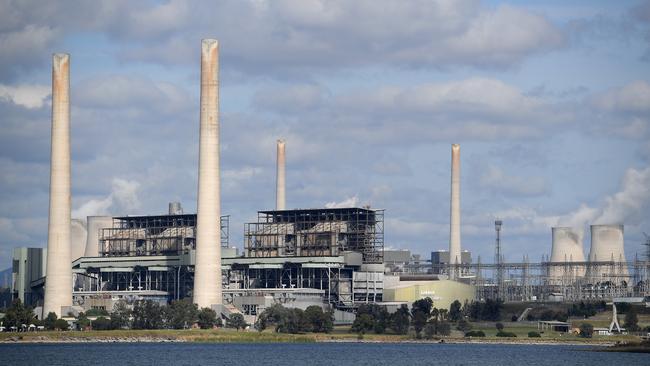King coal to rule for 20 more years, says independent energy market operator
The independent energy market operator has called for our coal-fired power plants to be operated for as long as possible.

The nation’s independent energy market operator has called for Australia’s fleet of coal-fired power plants to be operated for as long as possible to prevent a future price shock in the transition to renewables, claiming the ageing plants will still deliver the cheapest electricity for the next 20 years.
In a report commissioned by COAG into the energy and transmission requirements for the country, the Australian Energy Market Operator estimates the replacement cost of the generation capacity of the existing coal-fired network would be between $8 billion and $27bn by the mid-2030s.
It said extending the operation of the existing fleet of coal-fired generators for as long as the plants were economically viable would be “the least-cost option” for an orderly transition to renewables.
The report, while not advocating new coal generation, will have implications for the political battle between the government and energy giant AGL over the planned December 2022 closure of the Liddell power station in NSW, which the government argues could remain operational beyond that date.
It is the second independent report in a week to also back the Turnbull government’s national energy guarantee and a technology-neutral approach to addressing the energy supply and pricing crisis. But it contains an implicit warning that the system could not afford another premature coal-fired plant closure like Hazelwood in Victoria.
The AEMO report, to be released today by chief executive Audrey Zibelman, follows a report by the Australian Competition & Consumer Commission, which recommended the complete overhaul of the national energy market and suggested government underwrite new investments in generation, as well as setting a benchmark price for electricity. The report follows a cooling of tensions within the Coalition party room over the government’s energy policy with a partial backdown last week by the Nationals on their push for a new coal-fired power plant.
Resources Minister and coal advocate Matt Canavan said they were not wedded to a new coal plant but coal-fired power still needed to be contained in the NEG.
Some pro-coal Liberal MPs, however, are likely to seize on the report’s findings as a vindication of their push within the party room to invest in clean-coal-fired power as part of the energy mix into the future.
AEMO’s report, which addresses recommendations adopted by the government from the Finkel inquiry in 2016 and is titled the Integrated System Plan, maps the cost and architecture of transmission and generation needed in the energy market over the next two decades.
It claims the life of coal-fired power to deliver cheaper and reliable baseload power before the transition to a renewable energy future needs to be maintained for as long as possible. It also raises the risk of consumers wearing the transmission cost of connecting renewables to the grid if immediate action is not taken.
“Immediate action is required to maximise the economic use of existing low-cost generation. Investment is also required to facilitate the development of projected new renewable resources to replace retired and retiring resources, and to provide essential system security,” the report says. “Collectively, the (coal) generators expected to retire by 2040 produce around 70 terawatt hours (TWh), or 70,000 gigawatt hours (GWh), of energy each year.
“This is close to one-third of total NEM consumption. In addition to providing critical energy production and dispatchable power, conventional generators have also traditionally been relied on to provide essential grid security services, such as inertia, system strength, and frequency control.
“To support an orderly transition, ISP analysis demonstrates that, based on projected cost, the least-cost transition plan is to retain existing resources for as long as they can be economically relied on. Over the next 20 years, approximately 30 per cent of the NEM’s existing coal resources will be approaching the end of their technical lives, and will likely be retired, which highlights the importance of mitigating premature retirements as these resources currently provide essential low-cost energy and system support services required for the safe and secure operation of the power system.”
The report says the cost of renewables and storage has been falling and makes particular mention of the critical role of Snowy Hydro, and the Turnbull government’s proposed Snowy Hydro 2.0 in the future energy generation. “The investment profile and capabilities of various supply resources have changed and are projected to continue to change radically,” it says. “Costs of new renewable plant continue to fall, and advances and availability of storage technologies, particularly pumped hydro, flexible gas-powered generation and distributed energy resources, are emerging as vital elements to a low-cost and reliable-energy future.”
However, it raises concerns that transmission costs will rise significantly as more renewable energy comes on stream, with connecting infrastructure required to connect it to the national grid.
Immediate action is required, it says, to upgrade the transmission network, which is already one of the largest interconnected networks in the world. This involves projects to be completed by the mid-2020s for new transfer capacity between NSW and Victoria of 750MW and to increase transfer capacity between Victoria and South Australia by 100MW while capacity between Queensland and NSW should be increased by a further 378MW.
Immediate costs of transmission upgrades would be between $450 million and $650m. Longer term plans include renewable energy zones strategically located to minimise transmission costs. “It will be important to retain existing coal-fired generators until the end of their technical life to maintain reliability,” the report says, adding that replacement costs are “significant” and “unavoidable”.


To join the conversation, please log in. Don't have an account? Register
Join the conversation, you are commenting as Logout